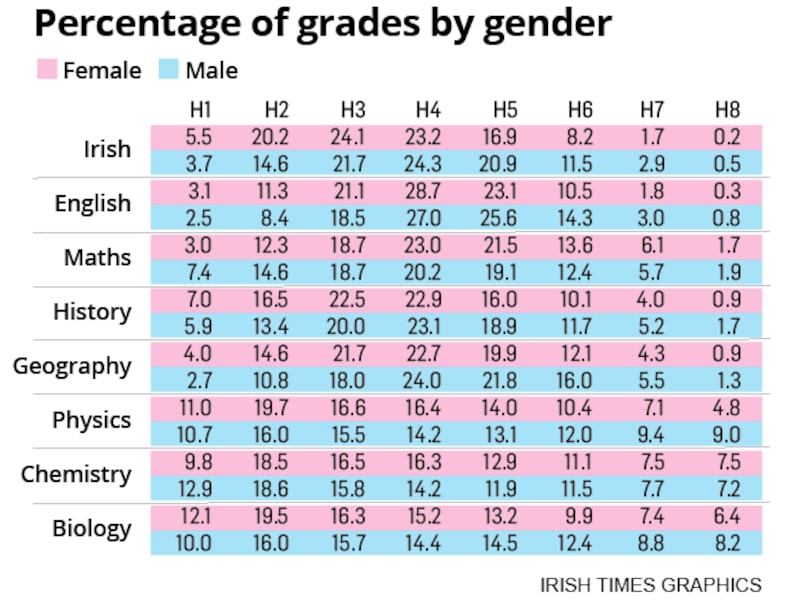Girls outperformed boys in the vast majority of higher level subjects, a gender analysis of this year’s Leaving Cert results shows.
In all, girls secured a higher proportion of top grades – H1s, H2s and H3s, or 70-100 per cent – in 34 out of 40 subjects at higher level.
Maths was one of just seven subjects at higher level where boys fared better than girls.
Other higher level subjects where boys were superior included applied maths, chemistry, agricultural economics, engineering and construction studies.
Overall, girls dominated the top grades across most other subjects such as languages, sciences and business courses.
By contrast, Northern Ireland boys have marginally outperformed girls at the top A-level grade for the first time.
They overtook girls by 0.4 per cent at the A* grade, which was first awarded in 2010.
The performance gap between the genders also narrowed at the A*-A grade boundary. This follows concerted efforts to address the disparity by education authorities.
Around 30,000 pupils in the north received their A-level and AS results on Thursday morning.
Stark differences
In the Leaving Cert, meanwhile, stark differences in participation rates across individual subjects remain, indicating that gender stereotypes are slow to shift.
Of almost 4,668 students who took engineering at higher level, some 93 per cent were boys.
Similarly, of the just over 7,100 students who sat the construction studies paper, almost 93 per cent were boys.

Even though girls were significantly outnumbered in other subjects such as economics, technology and design & communications graphics, they still managed to outperform boys.
The pattern in participation was reversed in subjects such as home economics, for which the vast majority of candidates were girls (91 per cent).
Other subjects where there were large majorities of girls included music (70 per cent) and art (60 per cent).
Girls were also more likely to study languages such as Irish, French and Spanish. In all cases, in the region of 60 per cent of candidates in these exams were girls.
Biology also attracted more girls. They accounted for 61 per cent of candidates.
Despite the performance gap among the genders , boys actually accounted for all seven high achievers who received eight top grades or H1s (90 to 100 per cent).
Separately, new research by the Educational Research Centre shows that 10-year-old girls outperformed boys on overall reading skills.
Reading skills
The report is based on an analysis of a major new international study – published last year – which examined reading skills among hundreds of thousands of fourth class pupils across 50 countries.
The trend of girls outperforming boys on overall reading skills was common across almost all countries.
It is somewhat depressing that young children still seem to fall back on gender stereotypes
The research also uncovered some gender differences in the type of texts which boys and girls enjoyed.
Author Mary Delaney said literary texts were generally less popular with Irish boys than girls. The exception was one text in which the main protagonists were animals, not humans.
“Boys were more enthusiastic about informational texts, and this is reflected in much smaller gender gaps on these texts.”
The research also found there was an incorrect assumption of maleness by pupils in particular contexts, such as where a scientist or explorer was mentioned.
Lead author Dr Eemer Eivers said: "It is somewhat depressing that young children still seem to fall back on gender stereotypes, such as assuming that a science writer is male, even when she is clearly flagged as a woman in the article."
She said there is more work to be done in identifying and addressing the “unconscious gender biases” that permeate everyday life.











